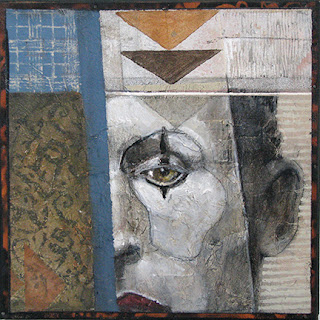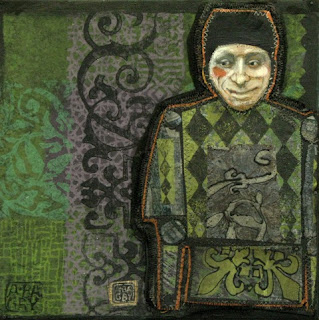I love enamels. When I was a kid, my parents had beautiful enameled items -- gorgeous cloisonné jewelry, platters and bowls, and (believe it or not) ashtrays. There was always something sensual and elegant about enamels – smooth deep color with lustrous surfaces, gorgeous gradation of colors and patterns. When I was in college, enamels were OUT. Pottery, painting, printmaking, drawing, sculpture, glass, design, etc. – all were options, but no enameling. I remember one of my professors telling me that enamels were difficult to do, “extremely specific and painstaking,” if I remember correctly. It seemed everyone wanted to distance themselves from enameling and the message I got was, “Don’t go there – it is too difficult, requires too many expensive materials and tools, and could potentially be hazardous to your health.” Well, thanks for nothing. 23 years ago, when I came to the Art Center we had a small enamel kiln unused sitting on a high shelf in the pottery studio. A few years later, we were given a second small kiln by another member. I didn’t know how to use them, nor did anyone else who was working in the program at the time. These sat years unused and unloved. Then Barbara Rothrock brought some gorgeous portraits of children (I think her grandchildren) in for an exhibition. These utterly fascinated me. They were beautiful and so very precise. Those idle kilns seemed less frightening suddenly. Our jewelry program began to grow and enameling kept popping up – especially as I kept seeing it used with Precious Metal Clay, which I had learned how to use from Ruth Prince. Enamels, it seemed, were everywhere and amazingly other mere mortals had learned to use them and lived to tell the tale and show the work. So we started talking and looking at the possibilities. George Kidd took a workshop and came back bearing the “torch” (I know, but I couldn’t resist the pun) for the medium. It turned out Ruth had done lots of enamels at UT in years past. We had the equipment! We had instructors and mentors! We had the beginnings of an enameling program! We just need converts! So…we have been trying to entice artists from other areas of our program to walk on the “enamel side” of art.
The National Enamelist Society awarded us a grant two years ago to purchase a pristine new kiln in a larger size with computer controller to help us pursue the program. We purchased the kilns and some very basic equipment to begin. George Kidd, taught several of us a few basics and got us started with the “bug” for enamels. We got an ABC grant (Arts Build Communities grant) to bring Bill Ellis, nationally known enamelist and superior teacher from John C. Campbell Folk School fame, to offer a beginning workshop for a large group the following year. Several of those students and George’s converts began meeting and working at the 3rd Friday Studios every month with some working between sessions on their own. However, the need for a kiln has stymied many of those individuals. It is difficult to pursue an art form if one can only work in it 2 hours a month. Ruth Prince gave us a taste of the spontaneity and delight that firing with a torch can elicit so we began to look for one of her teachers, Steve Artz. This year, the National Enamelists Society awarded us a grant to bring in Steve Artz to create “Torch Fired Enamels” with us on September 24th and 25 and (insert trumpet fanfare here) TA DAH! - newly bitten, fresh enamellists. This workshop was nothing short of fabulous. The work is immediate (you just have to love near instant gratification) with those same deep, rich colors, incredible high gloss or granular looking surfaces that begged to be touched. And that was just the enamels. Steve is a master of using all types of tools and tricks to create diverse surfaces with intense textures before adding the enamel. The enamel flows over these surfaces mimicking them, extolling them, or completely obliterating them, giving the viewer a complex surface design that fascinates. Add to that the characteristics fire creates (did I mention fire?) and a whole new spectrum of unique effects is now at the artist’s command. Beyond the surface, the material we were working on (36 gauge copper tooling foil) can be cut, crimped, folded or formed into almost any shape. Together, the materials and techniques offer each artist an immense array of possibilities – so many I imagine one could spend a lifetime experimenting and creating, always finding new problems to solve, new options, and new effects. That ever changing, ever new aspect is an artist’s well-spring -- it keeps you working and playing with the medium always pushing it just a bit further, seeking just a bit more control and satisfaction. Enamels are such a beautiful medium!
The beauty of Artz technique for me is the firing process – a gas torch. We used MAPP gas, although propane is also an option, but works more slowly. With the torch, enamels are almost immediate and rather than setting the timer and waiting for it to buzz when the enamels should be ready, I was watching the process happen, selecting the areas I wanted to give more heat and “flow” or the areas I wanted to back off on and in order to create an “orange peel” or grainy surface. Added to that, I could burn into areas, burn off edges and sides, create luster, and/or change back to the last look I had. With the torch, I could create effects as I chose and even revert, if I so desired. If I went too far, I evaluated the problems, the outcome, and began anew – it only takes a few minutes, so I had not lost much time in the process. It was exciting, wonderful and amazing all at once. From all I heard at the workshop, I was not alone in my opinion. The room was abuzz with excitement over the process and each person seemed totally engrossed in pursuing their own direction. Everyone delighted in the work. Everyone got beautiful pieces. All the pieces were unique to each person. Steve made books for us all to put some of our pieces in at the end of the workshop. It gave us a “finished” work by which we could remember the class. My book was not the most interesting or best from the class (trust me on this). But I do have plenty of pictures of it and have permission (ahem) to post them, so here they are.
The workshop had a few jewelry makers, a few painters, a potter or two and some “dabblers.” Each of us saw possibilities in how we could adapt and use enamels in our other work. As I said, the possibilities are just mind-blowing.
To the members of the National Enamelist Society, thank you. Thank you for igniting that spark of fascination. Now let’s see if we can make it flame.










